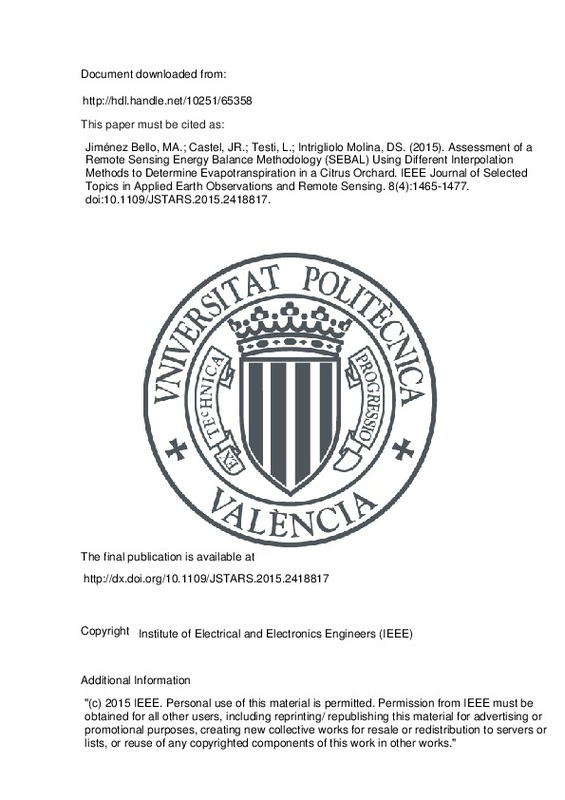JavaScript is disabled for your browser. Some features of this site may not work without it.
Buscar en RiuNet
Listar
Mi cuenta
Estadísticas
Ayuda RiuNet
Admin. UPV
Assessment of a Remote Sensing Energy Balance Methodology (SEBAL) Using Different Interpolation Methods to Determine Evapotranspiration in a Citrus Orchard
Mostrar el registro sencillo del ítem
Ficheros en el ítem
| dc.contributor.author | Jiménez Bello, Miguel Ángel
|
es_ES |
| dc.contributor.author | Castel, Juan R.
|
es_ES |
| dc.contributor.author | Testi, Luca
|
es_ES |
| dc.contributor.author | INTRIGLIOLO MOLINA, DIEGO SEBASTIANO
|
es_ES |
| dc.date.accessioned | 2016-06-07T07:29:14Z | |
| dc.date.available | 2016-06-07T07:29:14Z | |
| dc.date.issued | 2015-04 | |
| dc.identifier.issn | 1939-1404 | |
| dc.identifier.uri | http://hdl.handle.net/10251/65358 | |
| dc.description | "(c) 2015 IEEE. Personal use of this material is permitted. Permission from IEEE must be obtained for all other users, including reprinting/ republishing this material for advertising or promotional purposes, creating new collective works for resale or redistribution to servers or lists, or reuse of any copyrighted components of this work in other works." | es_ES |
| dc.description.abstract | A surface energy balance algorithm for land (SEBAL) for estimating evapotranspiration (ET) has been parameterized and tested in a 400-ha drip irrigated citrus orchard. Simultaneously, during three growing seasons, energy fluxes were measured using Eddy Covariance. Instantaneous fluxes obtained with SEBAL using 10 images from Landsat-5 were compared with the measured fluxes. The Perrier function was the best method for properly estimating the roughness momentum length for discontinuous canopies, as in citrus orchards. Crop height was estimated using LIDAR data. In general, SEBAL performed well for net radiation estimation but failed in soil heat flux estimation. Latent heat estimations from the SEBAL model had a relative root mean square error (rRMSE) of 0.06 when compared with measurements obtained by Eddy Covariance. Three procedures were tested for up-scaling the instantaneous ET estimates from SEBAL to daily ET values: 1) assuming the fraction between the actual ET and the reference ET is constant throughout the day; 2) using actual local crop coefficient curves; and 3) using an up-scaling factor where the fraction of hourly ET to daily ET equals the ratio of hourly to daily global solar radiation. This last method gave acceptable results for daily ET estimations (rRMSE = 0.09) and for 15day ET (rRMSE = 0.19), and its main advantage is that no local data are required. It is concluded that the SEBAL methodology can be successfully applied for determining actual ET, even in discontinuous citrus canopies. However, additional parameterizations of momentum roughness length were needed in order to obtain reliable ET determinations. | es_ES |
| dc.description.sponsorship | This work was supported in part by MINECO project Rideco-Consolider CSD2006-0067 and in part by Interreg IV Sudoe project "Telerieg." | en_EN |
| dc.language | Inglés | es_ES |
| dc.publisher | Institute of Electrical and Electronics Engineers (IEEE) | es_ES |
| dc.relation | Interreg IV Sudoe project "Telerieg" | es_ES |
| dc.relation.ispartof | IEEE Journal of Selected Topics in Applied Earth Observations and Remote Sensing | es_ES |
| dc.rights | Reserva de todos los derechos | es_ES |
| dc.subject | Terms-Citrus | es_ES |
| dc.subject | evapotranspiration | es_ES |
| dc.subject | remote sensing | es_ES |
| dc.subject | SEBAL | es_ES |
| dc.subject.classification | INGENIERIA HIDRAULICA | es_ES |
| dc.title | Assessment of a Remote Sensing Energy Balance Methodology (SEBAL) Using Different Interpolation Methods to Determine Evapotranspiration in a Citrus Orchard | es_ES |
| dc.type | Artículo | es_ES |
| dc.identifier.doi | 10.1109/JSTARS.2015.2418817 | |
| dc.relation.projectID | info:eu-repo/grantAgreement/MEC//CSD2006-00067/ES/Programa integral de ahorro y mejora en la productividad del agua de riego en la horticultura española/ | es_ES |
| dc.rights.accessRights | Abierto | es_ES |
| dc.contributor.affiliation | Universitat Politècnica de València. Instituto Universitario de Ingeniería del Agua y del Medio Ambiente - Institut Universitari d'Enginyeria de l'Aigua i Medi Ambient | es_ES |
| dc.contributor.affiliation | Universitat Politècnica de València. Departamento de Ingeniería Hidráulica y Medio Ambiente - Departament d'Enginyeria Hidràulica i Medi Ambient | es_ES |
| dc.description.bibliographicCitation | Jiménez Bello, MÁ.; Castel, JR.; Testi, L.; Intrigliolo Molina, DS. (2015). Assessment of a Remote Sensing Energy Balance Methodology (SEBAL) Using Different Interpolation Methods to Determine Evapotranspiration in a Citrus Orchard. IEEE Journal of Selected Topics in Applied Earth Observations and Remote Sensing. 8(4):1465-1477. https://doi.org/10.1109/JSTARS.2015.2418817 | es_ES |
| dc.description.accrualMethod | S | es_ES |
| dc.relation.publisherversion | http://dx.doi.org/10.1109/JSTARS.2015.2418817 | es_ES |
| dc.description.upvformatpinicio | 1465 | es_ES |
| dc.description.upvformatpfin | 1477 | es_ES |
| dc.type.version | info:eu-repo/semantics/publishedVersion | es_ES |
| dc.description.volume | 8 | es_ES |
| dc.description.issue | 4 | es_ES |
| dc.relation.senia | 299014 | es_ES |
| dc.identifier.eissn | 2151-1535 | |
| dc.contributor.funder | Ministerio de Educación y Ciencia | es_ES |
| dc.contributor.funder | Interreg | es_ES |







![[Cerrado]](/themes/UPV/images/candado.png)

